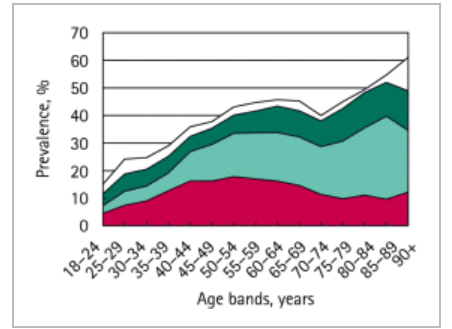[1]
Abrams P, Cardozo L, Fall M, Griffiths D, Rosier P, Ulmsten U, Van Kerrebroeck P, Victor A, Wein A, Standardisation Sub-Committee of the International Continence Society. The standardisation of terminology in lower urinary tract function: report from the standardisation sub-committee of the International Continence Society. Urology. 2003 Jan:61(1):37-49
[PubMed PMID: 12559262]
[2]
Lukacz ES, Santiago-Lastra Y, Albo ME, Brubaker L. Urinary Incontinence in Women: A Review. JAMA. 2017 Oct 24:318(16):1592-1604. doi: 10.1001/jama.2017.12137. Epub
[PubMed PMID: 29067433]
[3]
Khandelwal C, Kistler C. Diagnosis of urinary incontinence. American family physician. 2013 Apr 15:87(8):543-50
[PubMed PMID: 23668444]
[4]
Alves JO, Luz STD, Brandão S, Da Luz CM, Jorge RN, Da Roza T. Urinary Incontinence in Physically Active Young Women: Prevalence and Related Factors. International journal of sports medicine. 2017 Nov:38(12):937-941. doi: 10.1055/s-0043-115736. Epub 2017 Sep 26
[PubMed PMID: 28950397]
[5]
Buckley BS, Lapitan MC, Epidemiology Committee of the Fourth International Consultation on Incontinence, Paris, 2008. Prevalence of urinary incontinence in men, women, and children--current evidence: findings of the Fourth International Consultation on Incontinence. Urology. 2010 Aug:76(2):265-70. doi: 10.1016/j.urology.2009.11.078. Epub 2010 Jun 11
[PubMed PMID: 20541241]
[6]
. Managing acute and chronic urinary incontinence. AHCPR Urinary Incontinence in Adults Guideline Update Panel. American family physician. 1996 Oct:54(5):1661-72
[PubMed PMID: 8857788]
[7]
Irwin DE, Kopp ZS, Agatep B, Milsom I, Abrams P. Worldwide prevalence estimates of lower urinary tract symptoms, overactive bladder, urinary incontinence and bladder outlet obstruction. BJU international. 2011 Oct:108(7):1132-8. doi: 10.1111/j.1464-410X.2010.09993.x. Epub 2011 Jan 13
[PubMed PMID: 21231991]
[8]
Brown JS, Bradley CS, Subak LL, Richter HE, Kraus SR, Brubaker L, Lin F, Vittinghoff E, Grady D, Diagnostic Aspects of Incontinence Study (DAISy) Research Group. The sensitivity and specificity of a simple test to distinguish between urge and stress urinary incontinence. Annals of internal medicine. 2006 May 16:144(10):715-23
[PubMed PMID: 16702587]
[9]
Khan MJ, Omar MA, Laniado M. Diagnostic agreement of the 3 Incontinence Questionnaire to video-urodynamics findings in women with urinary incontinence: Department of Urology, Frimley Health NHS Foundation Trust Wexham Park Hospital Slough, Berkshire, United Kingdom. Central European journal of urology. 2018:71(1):84-91. doi: 10.5173/ceju.2018.1622. Epub 2017 Feb 21
[PubMed PMID: 29732212]
[10]
Hu JS, Pierre EF. Urinary Incontinence in Women: Evaluation and Management. American family physician. 2019 Sep 15:100(6):339-348
[PubMed PMID: 31524367]
[11]
Swift S, Barnes D, Herron A, Goodnight W. Test-retest reliability of the cotton swab (Q-tip) test in the evaluation of the incontinent female. International urogynecology journal. 2010 Aug:21(8):963-7. doi: 10.1007/s00192-010-1135-z. Epub 2010 Apr 9
[PubMed PMID: 20379698]
[12]
. Committee Opinion No. 603: Evaluation of uncomplicated stress urinary incontinence in women before surgical treatment. Obstetrics and gynecology. 2014 Jun:123(6):1403-1407. doi: 10.1097/01.AOG.0000450759.34453.31. Epub
[PubMed PMID: 24848922]
Level 3 (low-level) evidence
[13]
Subak LL, Quesenberry CP, Posner SF, Cattolica E, Soghikian K. The effect of behavioral therapy on urinary incontinence: a randomized controlled trial. Obstetrics and gynecology. 2002 Jul:100(1):72-8
[PubMed PMID: 12100806]
Level 1 (high-level) evidence
[14]
Imam KA. The role of the primary care physician in the management of bladder dysfunction. Reviews in urology. 2004:6 Suppl 1(Suppl 1):S38-44
[PubMed PMID: 16985854]
[15]
Gormley EA, Lightner DJ, Burgio KL, Chai TC, Clemens JQ, Culkin DJ, Das AK, Foster HE Jr, Scarpero HM, Tessier CD, Vasavada SP, American Urological Association, Society of Urodynamics, Female Pelvic Medicine & Urogenital Reconstruction. Diagnosis and treatment of overactive bladder (non-neurogenic) in adults: AUA/SUFU guideline. The Journal of urology. 2012 Dec:188(6 Suppl):2455-63. doi: 10.1016/j.juro.2012.09.079. Epub 2012 Oct 24
[PubMed PMID: 23098785]
[16]
Morhason-Bello IO, Adebayo SA, Abdusalam RA, Bello OO, Odubamowo KH, Lawal OO, Olapade-Olaopa EO, Ojengbede OA. Bilateral double ureters with bladder neck diverticulum in a nigerian woman masquerading as an obstetric fistula. Case reports in urology. 2014:2014():801063. doi: 10.1155/2014/801063. Epub 2014 Dec 23
[PubMed PMID: 25587483]
Level 3 (low-level) evidence
[17]
Riemsma R, Hagen S, Kirschner-Hermanns R, Norton C, Wijk H, Andersson KE, Chapple C, Spinks J, Wagg A, Hutt E, Misso K, Deshpande S, Kleijnen J, Milsom I. Can incontinence be cured? A systematic review of cure rates. BMC medicine. 2017 Mar 24:15(1):63. doi: 10.1186/s12916-017-0828-2. Epub 2017 Mar 24
[PubMed PMID: 28335792]
Level 1 (high-level) evidence
[18]
Suskind AM, Dunn RL, Morgan DM, DeLancey JO, McGuire EJ, Wei JT. The Michigan Incontinence Symptom Index (M-ISI): a clinical measure for type, severity, and bother related to urinary incontinence. Neurourology and urodynamics. 2014 Sep:33(7):1128-34. doi: 10.1002/nau.22468. Epub 2013 Aug 14
[PubMed PMID: 23945994]
[19]
Hajebrahimi S, Corcos J, Lemieux MC. International consultation on incontinence questionnaire short form: comparison of physician versus patient completion and immediate and delayed self-administration. Urology. 2004 Jun:63(6):1076-8
[PubMed PMID: 15183953]
[20]
Klovning A, Avery K, Sandvik H, Hunskaar S. Comparison of two questionnaires for assessing the severity of urinary incontinence: The ICIQ-UI SF versus the incontinence severity index. Neurourology and urodynamics. 2009:28(5):411-5. doi: 10.1002/nau.20674. Epub
[PubMed PMID: 19214996]
[21]
Stickley A, Santini ZI, Koyanagi A. Urinary incontinence, mental health and loneliness among community-dwelling older adults in Ireland. BMC urology. 2017 Apr 8:17(1):29. doi: 10.1186/s12894-017-0214-6. Epub 2017 Apr 8
[PubMed PMID: 28388898]
[22]
Demaagd GA, Davenport TC. Management of urinary incontinence. P & T : a peer-reviewed journal for formulary management. 2012 Jun:37(6):345-361H
[PubMed PMID: 22876096]
[23]
Chapple CR, Cardozo L, Nitti VW, Siddiqui E, Michel MC. Mirabegron in overactive bladder: a review of efficacy, safety, and tolerability. Neurourology and urodynamics. 2014 Jan:33(1):17-30. doi: 10.1002/nau.22505. Epub 2013 Oct 11
[PubMed PMID: 24127366]
[24]
Bland DR, Dugan E, Cohen SJ, Preisser J, Davis CC, McGann PE, Suggs PK, Pearce KF. The effects of implementation of the Agency for Health Care Policy and Research urinary incontinence guidelines in primary care practices. Journal of the American Geriatrics Society. 2003 Jul:51(7):979-84
[PubMed PMID: 12834518]

